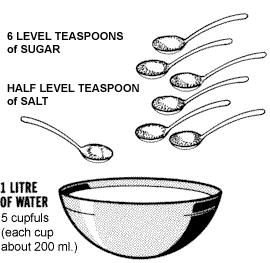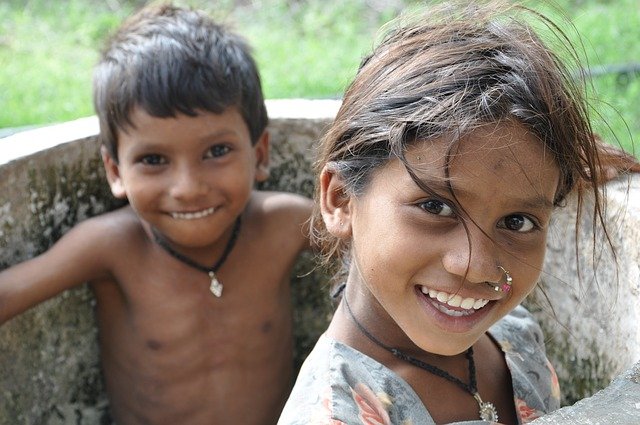Introduction:
The very existence of Mankind is an amazing wonder in our universe; how we live, move and think.
Much more amazing is the rate at which we grow, learn and evolve. This Growth rate is markedly astonishing within the first few years of life, where development is rapid.
During these stages also, the Child's Body is susceptible to a number of challenges which would be properly handled by the adult.
Hence diseases in children are sometimes much more severe. For this post, I will be presenting childhood diarhoael disease, how it kills our children and very effective way to save them.
Basic Definitions Of Concepts
•Diarrhoea:
The passage of 3 or more loose or Liquid stools per day(or more frequent passage than is normal for the individual). Frequent passing of formed stools is not diarrhoea!
Diarrhoea is a symptom of a disease occuring in the gastrointestinal tract and not a disease on its own.
Types Of Diarrhoea
- Acute watery diarrhoea - lasts several hours or days and includes cholera
- Acute bloody diarrhoea -- Dysentery
- Persistent diarrhoea --lasts 14 days or longer
•Dehydration
The most severe threat posed by diarrhoea is dehydration. As a child experiences episodes of diarrhoea, He/She loses water and electrolytes(sodium, Potassium, Chloride, and bicarbonate) through liquid stools, vomit(if associated with vomiting), in addition to normal loses through urine, sweat, and breathing.
Dehydration will occur when the continuous reduction of body fluids is not being replaced.
Dehydration has been categorized by the World Health Organization as:
- Severe dehydration
- Some dehydration
- No dehydration
It is easy to know diarrhoea. But how do we know dehydration?
These are very Important signs of Dehydration.
Severe Dehydration:
- Child could be extremely tired and uninterested in the environment(lethargy) or completely unconscious.
- The eyes May appear sunken
- He/she may not want to drink or would drink poorly.
- If the skin is pinched, it returns slowly.
You need at least two of these signs to call it severe dehydration. When you see one sign, don't wait, advance to look for others!
Some dehydration
- Child may cry incessantly, display restlessness or irritability.
- The eyes may also be sunken
- child drink eagerly and is thirsty.
Recall that child would not drink at all or drinks poorly!
What are the common causes of Infectious diarrhoea in our environment?
- They could be bacterial, Viral or Parasitic.
These are more common where there is shortage of adequate sanitation and safe drinking water. Some common organisms include: - Rotavirus(the commonest in children <2 years)
- Esherichia coli - The commonest bacterial cause in our environment.
- Shigella spp
- Vibrio cholera
- Campylobacter Jejuni
- Cryptosporidium spp
- Amoeba
The common routes of spread of Infection may be easily be remembered using the 4 F's of diarrhoea:
- Food :contaminated by faeces or unclean water
- Fingers: could harbour infection when not properly washed before eating
- Flies: May have visited contaminated places afterwhich they perch on food not previously contaminated.
- Faeces: Direct contamination from which other sources take their roots.
V.I.P point:
According to UNICEF, one gram of human feces may contain 10 million viruses, 1 million bacteria , 1,000 parasite cysts and 100 parasite eggs.
Source
How infectious diarrhoea may lead to dehydration in our Children
This could occur in 3 ways:
- The organisms attach to the intestinal absorptive surfaces(villi), causing a dysfunction which leads to reduced absorption and increased passage down the gastrointestinal tract.
- The inflammatory response mounted against diarrhoea-causing organisms leads to excessive secretion of fluids by the intestines into the gastrointestinal tract.
- By causing direct damage to the intestinal wall, both of these mechanisms could occur simultaneously, leading to large amounts of diarrhoea, blood and rapid dehydration e.g In Diarrhoea caused by shigella
Why is it Important to aggressively manage diarrhoea?
- Diarhhoeal disease is the second leading cause of death in children under 5 years of age.
- Each Year diarrhoea kills around 525,000 children under five years of age
- Globally, Nearly 1.7 Million cases of Childhood diarrhoeal disease every year.
What to do as soon as Diarrhoea is suspected
The best action one could possibly take against diarrhoea is prevention. Most times this is not feasible due to poor hygienic status among our little children, Inadequate resources to provide pottable water, epidemics of the diseases and Low socioeconomic status.
If Diarrhoea occurs, the Best of all measures is to visit your doctor/health centre as soon as possible.
If certain factors such as distance, bad timing delays hospital or health care centre visits,
Here is something you can do!
Rehydration of the sick Child:
Since the child is loosing fluid continuously through faeces, vomitting(if present) in addition to Sweat, urine and expiration, Dehydration must be prevented or corrected.
With the help of a solution named oral rehydration salt solution(ORS), the fluid and electrolyte composition of body fluids may be corrected adequately.
The Commercial production of ORS has been ongoing for a while now. Bodies such as WHO and UNICEF have made available a number of ORS salts.
A practical way to Prepare ORS right now!
Ingredients needed:
- Clean water
- Sugar
- Salt
Apparatus:
- Teaspoon
- 2 Containers for ORS Fluid(preferrably 1 Litre per container)
Method: To a litre of Clean water, add:
- 6 level teaspoons of sugar
- ½ Level teaspoons of salt
Allow it to dissolve
 source
source
Administration of your Home made ORS solution
It is good to know the weight of the child before attempting correction of dehydration.
Weigh the Child thus:
If child can stand, read weight off the balance directly
If child cannot stand due to lethargy, carry the child and Mount the scale while carrying the Child. Subtract your weight from the result to get child's weight.
WHO recommends a quanity of 75mls for every kilogram of the child's weight for Some dehydration.
Multiply 75mls by the weight of the child to get amount in mls of ORS prepared.
For A 20kg child, Needed solution = 20 × 75
You get 1,500mls(1.5 Litres)
Child would need One and a Half bottles of your prepared ORS
Also, for every Episode of Diarrhoea or vomitting, give 10mls per kilogram of Body weight.
Multiply 10 by 20kg for example, you get 200mls. Give that immediately after the episodes while you continue ORS for over 4 hours.
While giving your Home prepared ORS, get ready to visit the healthcentre.
For severe dehydration where child can't drink, See health care centre as soon as possible as death might be imminent.
What you Must not do:
- Never force a child to drink. Give small sips of ORS or allow child to drink liberally.
- Don't use Only water to rehydrate
- Do not administer antibiotics or anti-diarrhoeal drugs. See a doctor.
Drugs do not correct dehydration.
References/Citation
http://www.who.int/elena/titles/bbc/dehydration_sam/en/
https://www.webmd.com/digestive-disorders/features/prevent-dehydration
http://www.who.int/topics/diarrhoea/en/
http://rehydrate.org/solutions/homemade.htm
Spread the information.
Visit Air-clinicfor more Information on Childhealth.
Download air-clinic android app here
Follow via Steemit @Air-clinic
Follow me @wordswithhoney on steemit or @khallie on Air-clinic.
.png)

Congratulations @wordswithhoney! You have completed the following achievement on Steemit and have been rewarded with new badge(s) :
Click on the badge to view your Board of Honor.
If you no longer want to receive notifications, reply to this comment with the word
STOPHi @wordswithhoney, I'm @checky ! While checking the mentions made in this post I found out that @khallie doesn't exist on Steem. Maybe you made a typo ?
If you found this comment useful, consider upvoting it to help keep this bot running. You can see a list of all available commands by replying with
!help.